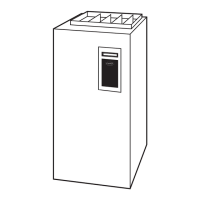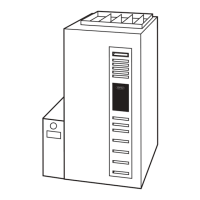Never purge a gas line into a combustion chamber. Never test
for gas leaks with an open flame. Use a commercially
available soap solution made specifically for the detection of
leaks to check all connections. Failure to follow this warning
could result in fire, explosion, personal injury, or death.
Step 5—Sequence of Operation
Furnace control must be grounded for proper operation, or
control will lock out. Control is grounded through
green/yellow wire routed to gas valve and burner box screw.
Failure to follow this caution will result in intermittent unit
operation.
Using schematic diagram, follow sequence of operation through
different modes. (See Fig. 31.) Read and follow wiring diagram
carefully.
NOTE: If a power interruption occurs during a call for heat
(W/W1 or W/W1-and-W2), the control will start a 90-second
blower-only ON period two seconds after power is restored, if the
thermostat is still calling for gas heating. The amber LED light will
flash code 12 during the 90-second period, after which the LED
will be ON continuous, as long as no faults are detected. After the
90-second period, the furnace will respond to the thermostat
normally.
The blower door must be installed for power to be conducted
through the blower door interlock switch ILK to the furnace
control CPU, transformer TRAN, inducer motor IDM, blower
motor BLWM, hot-surface igniter HSI, and gas valve GV.
SINGLE-STAGE THERMOSTAT AND TWO-STAGE
HEATING (ADAPTIVE MODE)
See Fig. 28 or 61 for thermostat connections
NOTE: Low-heat-only switch, SW1-2, selects either the low-
heat-only operation mode when ON, (see item 2. below) or
adaptive heating mode when OFF, in response to a call for heat.
(See Fig. 32.) When the W2 thermostat terminal is energized, it
will always cause high-heat operation when the R to W circuit is
closed, regardless of the setting of the low-heat only switch.
This furnace can operate as a two-stage furnace with a single-stage
thermostat because furnace control CPU includes a programmed
adaptive sequence of controlled operation, which selects low-heat
or high-heat operation. This selection is based upon the stored
history of the length of previous gas heating periods of the
single-stage thermostat.
The furnace will start up in either low- or high-heat. If the furnace
starts up in low-heat, the furnace control CPU determines the
low-heat on time (from 0 to 16 minutes) which is permitted before
switching to high-heat.
If power is interrupted, the stored history is erased. When this
happens, the control CPU will initially select low-heat for up to 16
minutes and then switch to high-heat, as long as the thermostat
continues to call for heat. Subsequent selection is based on stored
history of thermostat cycle times.
The wall thermostat ″calls for heat″, closing the R to W circuit.
The furnace control CPU performs a self-check, verifies the
low-heat and high-heat pressure switch contacts LPS and HPS are
open.
1. Inducer Prepurge Period-The furnace control CPU turns on
inducer motor IDM and slowly increases the inducer motor
speed. When the low-heat pressure switch LPS closes, inducer
motor RPM is noted by the furnace control CPU, and a 25-sec.
prepurge period begins. The RPM is used to evaluate vent
system resistance. This evaluation is then used to determine
the required RPM necessary to operate the inducer motor
during the low-heat prepurge period and low-heat mode.
NOTE: The heat cycle can start in either high-or low-heat. If a
high-heat cycle is initiated, the furnace control CPU will de-
energize the high-heat pressure switch relay HPSR to close the NC
contact and continues to increase the inducer motor speed after the
low-heat pressure switch LPS closes. When the high-heat pressure
switch closes, inducer motor RPM is noted by the furnace control
Table 9—Furnace Setup Switch Description
SETUP
SWITCH NO.
SWITCH
NAME
NORMAL
POSITION
DESCRIPTION
OF USE
SW1-1 Status Code Recovery OFF
Turn ON to retrieve up to 7 stored status codes for troubleshooting
assistance when R thermostat lead is disconnected.
SW1-2 Adaptive Heat Mode OFF
Allows 2-stage operation with a single stage thermostat.
Turn ON when using 2 stage thermostat to allow Low Heat opera-
tion when R to W/W1 closes and High Heat operation when R to
W/W1 and W2 close.
SW1-3
Low Heat
Rise Adjust
OFF
Turn ON to increase Low Heat airflow by 18 percent. This compen-
sates for increased return air temperature caused with bypass hu-
midifier.
SW1-4 Comfort/Efficiency Adjustment ON
Turn ON to decrease Low Heat airflow by 7 percent and High Heat
airflow 8 percent for maximum comfort. On 040 unit will decrease
Low-Heat Airflow 11 percent and High-Heat Airflow 10 percent.
SW1-5 CFM per ton adjust OFF Turn ON for 400 CFM per ton. Turn OFF for 350 CFM per ton.
SW1-6 Component Self-Test OFF
Turn ON to initiate Component Self-Test for troubleshooting assis-
tance when R thermostat lead is disconnected.
Turn OFF when Self-Test is completed.
SW1-7 Blower OFF delay ON or OFF
Control blower Off Delay time. Used in conjunction with SW1-8. See
Table 10.
SW1-8 Blower OFF delay ON or OFF
Control blower Off Delay time. Used in conjunction with SW1-7. See
Table 10.
Table 10—Blower Off Delay Setup Switch
Position
DESIRED HEATING
MODE BLOWER
OFF DELAY (SEC)
SETUP SWITCH (SW1-7 AND SW1-8) POSITION
SW1-7 SW1-8
90 OFF OFF
120 ON OFF
150 OFF ON
180 ON ON
37
→

